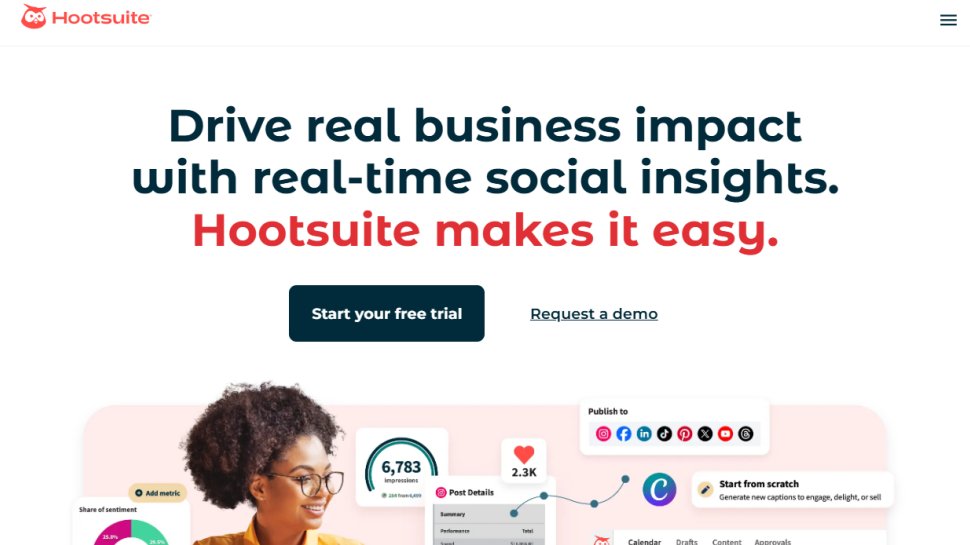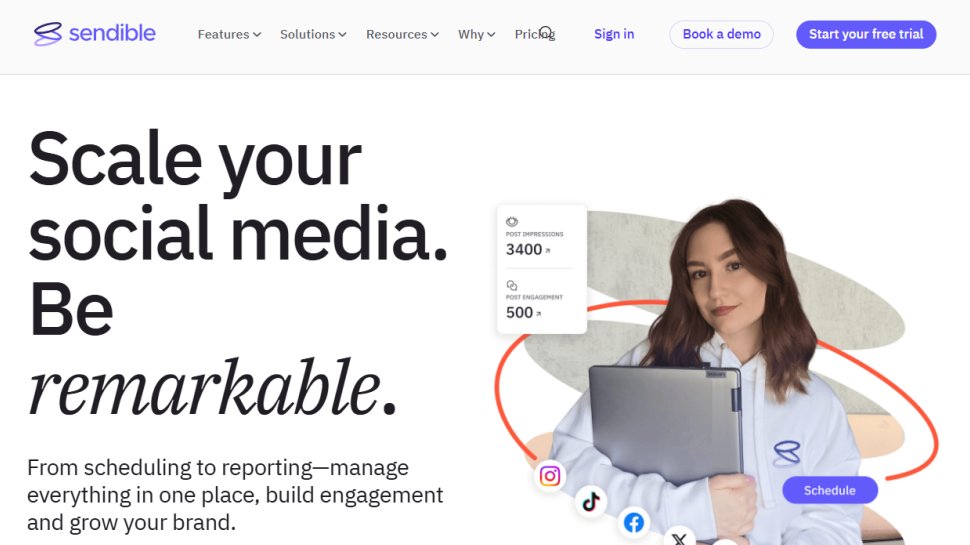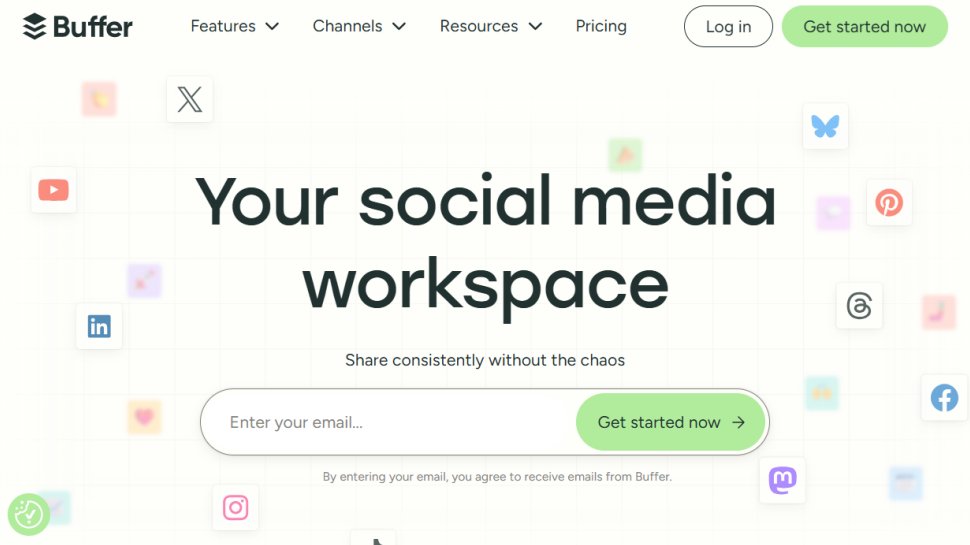Best content calendar software of 2025
Manage your social media posting more effectively

We list the best content calendar software, to make it simple and easy to manage your social media posting more effectively.
Scheduling is essential for every person whose work revolves around publishing regular content, e.g., journalists, social media managers, and vloggers. Businesses focused on creating content also need scheduling to perform their work effectively.
It’s challenging to plan a content schedule manually. Many software developers observed this need and created content calendar platforms to assist people. There are endless such platforms, and it can be challenging to pick the best one. However, we’ve created this guide to help you.
We’ll show you the best content calendar software you can choose in 2024. We conducted extensive research and testing and curated our list based on vital considerations, including pricing, features, ease of use, customer service, and more.
Launch multi-channel campaigns with HubSpot
HubSpot’s social media management tools connect publishing to performance. Plan campaigns across social, email, and ads from one workspace, collaborate in real time, and see which content turns engagement into pipeline and revenue.
TechRadar Pro Approved Sponsored Offer
We've also featured the best calendar app of 2025.
The best content calendar software of 2025 in full:
Why you can trust TechRadar
Best content calendar software for user friendliness
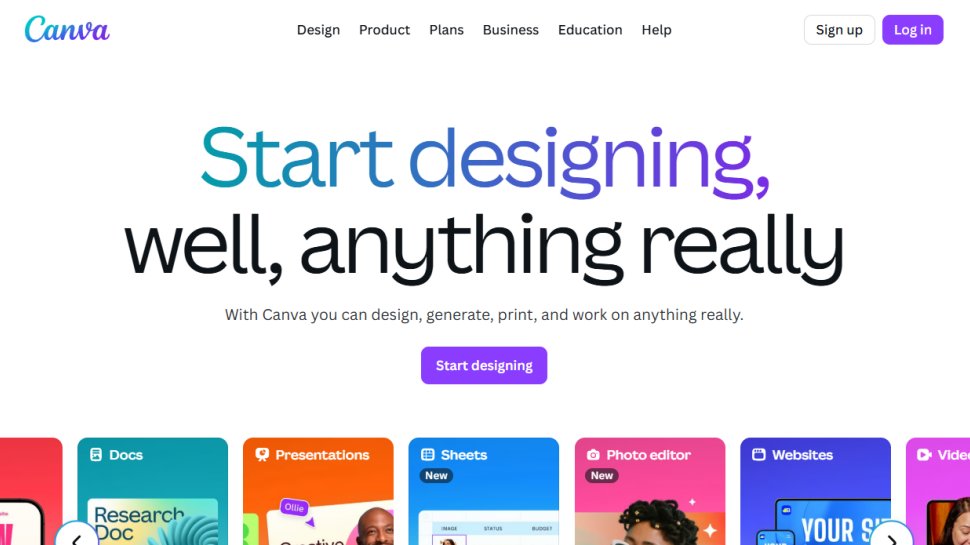
Reasons to buy
Reasons to avoid
Canva and user-friendliness are synonymous with each other. It’s one of the most intuitive tools you can use, and the content calendar is no different. You have access to a neatly designed calendar to plan and schedule your upcoming posts. You can edit and monitor your content schedule anytime.
We put Canva on this list because it combines sophisticated design tools with a content calendar. You can use Canva’s design tool to create stunning graphics for your social media page and post them directly from your dashboard. Of course, direct posting requires linking Canva to your social media account beforehand.
Features
Canva is best known as a design tool, and you’d be forgiven for wondering why it’s on its list. The reason is that Canva offers a content calendar tool as part of the advanced features accessible to Pro subscribers.
Canva Pro provides a content calendar to schedule and plan your posts effectively. The great thing about using Canva Pro as a content planner is that you use Canva to design excellent posts and schedule them for posting on the same platform.
This platform has integrations with Facebook, Instagram, Twitter, and LinkedIn, allowing you to post directly without leaving Canva. However, Canva Pro lacks integration with many other social media platforms at this point.
Read our full Canva review here.
Best content calendar software for marketing

Reasons to buy
Reasons to avoid
HubSpot’s Marketing Hub has several features of interest to contend for the best content calendar software. For instance, the platform offers a comprehensive suite of tools for managing marketing campaigns and social media, complete with built-in analytics to measure performance.
What’s more, since HubSpot offers multiple products and services, you’re going to get some extra marketing tools as well. Plus, being the giant that it is, the platform has many integrations, as well.
Features
With HubSpot, you’ll get a single, visual, drag-and-drop calendar for planning and overseeing all marketing efforts. With it you can view, schedule, and organize blog posts, social media messages, email campaigns, website pages, and so on.
Also, with HubSpot, you can post to social media from the same place you create your campaigns, set up alerts to see whenever your brand is mentioned online, and connect everything to your CRM so you can have informed conversations and see how well your social efforts are paying off.
Since the platform is more than just a content calendar, you can create keyword alerts to spot important mentions and automatically email the sales team when prospects talk about specific topics.
Built-in social reports are available as well to help you see how your social posts are performing across different networks, campaigns, and times. Since HubSpot connects to your CRM, you can also see exactly how many website visits, leads, and customers are coming from social media.
The whole platform is generally intuitive and easy to use, but to get all of these features, it can be pricey. While there is a free plan and $9 per month plan, to get the campaign and social media management (and a lot of other features), you’ll need to pay $792 per month on annual billing.
Read our full HubSpot review.
Best content calendar software overall
Reasons to buy
Reasons to avoid
Hootsuite is a versatile content calendar tool for social media. It is integrated with the most popular social media platforms, allowing you to plan and publish posts directly from Hootsuite. Let’s look at how it performs in various criteria.
Interface
Hootsuite has an intuitive interface. Despite packing many features, the dashboard is designed in a way that’s easy to understand. You have a calendar, which you can use to plan your content. You can create the content draft and drag it into the calendar at the desired date. Once this date (and specified time) is reached, the content automatically gets published on your social account.
Hootsuite lets you see your schedule and adjust things anytime. The platform is accessible via a web browser, desktop app, and mobile app. You get full access to your social media calendar on the go, switching between different devices based on convenience.
Features
Hootsuite began as a platform to let people connect multiple social accounts in one dashboard and use a single calendar to schedule and publish content. The platform has retained this core feature, offering an easy way for social media managers to create and publish content.
On Hootsuite, you can access helpful tools to help you publish creative content. For example, you can upload designs directly from Canva or use images from a vast stock library. This platform also offers artificial intelligence (AI) writing assistance that helps users generate compelling text for social media posts. Likewise, an existing library of content templates gives you ideas to create your own compelling content.
Overall
The main drawback of Hootsuite is its cost. It offers many valuable features but is an expensive tool for individuals and small businesses.
Read our full Hootsuite review.
Best content calendar software for social media

Reasons to buy
Reasons to avoid
Sprout Social offers a user-friendly interface. It doesn’t take much to understand and use this software effectively. Sprout Social does a great job of helping new users familiarize themselves with the dashboard.
You have a user-friendly calendar that serves as your content scheduler. You drag and drop content into this calendar, and you can monitor your schedule at all times. Sprout Social is accessible via the web or a mobile app (iOS and Android). The mobile app enables you to monitor your upcoming social posts and make changes on the go; it has the same features you’ll find on the browser interface.
Features
Sprout Social is an advanced social media management platform. Its features include a content calendar that allows you to schedule and publish social content directly from Sprout Social. This platform has integrations with virtually all popular social media platforms, meaning you can post directly to multiple platforms instead of logging in and posting individually.
After creating a post draft, you can drag and drop it into any date on your content calendar. Once that date is reached, Sprout Social automatically publishes the post for you.
Sprout Social also allows businesses to gather messages from all their social accounts (LinkedIn, Facebook, Instagram, etc.) in one inbox and respond directly from their Sprout Social dashboard.
Read our full Sprout Social review.
Best free Best content calendar software tool
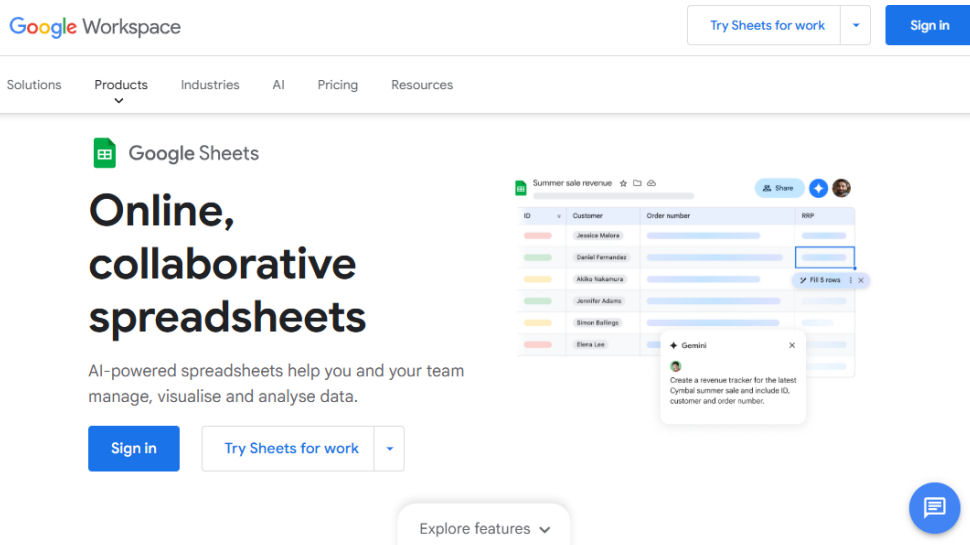
Reasons to buy
Reasons to avoid
Google Sheets is best known as a spreadsheet tool, not a content calendar tool. However, this free tool can also function as a content calendar.
The Google Sheets platform has an interface that’s easy to understand. It allows you to create spreadsheets like on Microsoft Excel or any other spreadsheet app. You can use a spreadsheet to plan and manage your content schedule at no additional cost. Google Sheets already comes with calendar templates, so you can choose anyone to form the basis of your content calendar.
Google Sheets is accessible via a web browser or mobile app. You can view and edit your content calendar from any device where you’re logged into your Google account.
Features
Google Sheets allows users to create spreadsheets seamlessly. It has a template library where you can find pre-existing calendars to form the foundation of your content calendar. If the pre-made templates aren’t suitable, you can also download external templates and use them on Google Sheets.
This platform acts as a simple content management tool. It wasn’t built as a content calendar software and, therefore, lacks direct integrations with social media platforms. You can not schedule and post content directly as you’d do on Sprout Social, ContentStudio, and the like. There’s also no analytics dashboard to monitor the performance of your social posts; you have to do that directly on your social media account.
Collaboration is a major aspect of using Google Sheets. You can easily share your content calendar by generating a shareable link. You decide what someone who opens the shareable link can do: view, edit, or comment. Other users can easily adjust your content calendar if you permit them to.
Pricing
We picked Google Sheets as the best free content calendar tool. It’s completely free for individual users. Businesses subscribed to Google Workspace can also enjoy Google Sheets as part of their subscription.
Read our full Google sheets review.
Best content calendar software for teams

6. Content Studio
Reasons to buy
Reasons to avoid
ContentStudio scores high in the user-friendliness criterion. The platform offers a minimal, uncluttered interface you’ll likely enjoy using. Features are arranged neatly across the dashboard, with a white background contrasted by colored buttons. The arrangement makes finding just the feature you want at a specific time easy.
You can access ContentStudio from the web-based interface or mobile app (iOS and Android). Both mediums give you access to the same intuitive content calendar to plan your posting schedule. ContentStudio is a collaborative tool that allows you to share your calendar with colleagues and receive feedback.
Features
ContentStudio makes planning, managing, and organizing your social media content easy. It gives users a visually appealing calendar to plan and schedule posts. Of course, this platform has integrations with social media platforms, allowing you to schedule posts ahead of time and get them posted automatically at the specified time.
ContentStudio doesn’t just let you plan and post content. It also gives detailed analytics about your social posts so you can know where to improve. You can monitor your post engagement on different social platforms directly from one dashboard, removing the stress of juggling different apps to view your analytics.
Generative artificial intelligence is all the rage now, and ContentStudio isn’t left out. It offers an AI assistant that helps you generate compelling text and images for your social media campaigns. The AI assistant also gives ideas for posts that you want to write.
Best content calendar software for marketing agencies
7. Sendible
Reasons to buy
Reasons to avoid
Sendible has a great interface that makes it easy to manage your content. You have an interactive calendar where you can schedule social posts ahead of time. Sendible was designed for content marketing agencies working with multiple clients, so the app makes it easy to share your work with relevant clients.
A unique thing about Sendible is that it offers a white-labeled version. You can customize the interface to use your brand instead of Sendible’s. A customized interface looks more professional when you share a content calendar with external clients. The white-labeled platform costs significantly more than the normal one, but it’s worth it for large marketing agencies wanting to stand out from competitors.
Features
Sendible is designed to foster collaboration between content marketing agencies and their external clients. The platform allows multiple colleagues to collaborate seamlessly. You can tag colleagues on your content calendar, and they can leave comments and suggestions.
Sendible comes with advanced tools to help you create social content. For instance, a built-in editor lets you crop your images to suit each social platform's ratio requirements. You have access to a template library that gives you valuable content ideas. You can select GIFs from Giphy and stock images from Pexels to engage your audience.
It’s not enough to just schedule and post content. Sendible gives you tools to analyze your post engagement and reach, although the reporting dashboard is not as advanced as what you’d find on some competitors.
Overall
Sendible is a cost-effective solution for content marketing agencies with dozens of users. It offers a 14-day free trial for each plan, allowing users to test the features before making a final decision.
Best AI-powered content calendar software

8. StoryChief
Reasons to buy
Reasons to avoid
StoryChief has a responsive user interface that feels enjoyable. You have an interactive calendar to plan your content and schedule posts ahead of time. You can create color-coded categories for different types of content and make each one stand out.
A slight drawback we observed is that StoryChief’s calendar doesn’t have a drag-and-drop interface. You can’t drag a scheduled post from one date to another in the calendar, as you’d do on many rival tools. Instead, you must click on the actual post and change the date.
Another drawback is that StoryChief doesn’t have a mobile app. You can only access it on a web browser.
Features
StoryChief is a versatile content management platform with the calendar as one of its main features. The calendar allows you to plan your social posts meticulously and schedule posts ahead of time. StoryChief has direct integrations with over 100 social platforms, allowing you to post content directly from your dashboard.
You can monitor the performance of your content across different social platforms directly from your StoryChief dashboard. You’ll see vital metrics about your post engagement, enabling you to decide when to change your strategy.
One of the best things about using StoryChief is the platform’s AI writing assistant. You can use this assistant to help you generate effective marketing posts. You can feed the assistant prompts, and it’ll output relevant text based on your queries. The assistant can also help you adjust your written text to sound better for the target audience. It can help with keyword research and other activities that help your social posts rank high.
StoryChief offers a 7-day free trial with no card details needed. It’s a costly tool compared to the competition.
Best content calendar software for Instagram
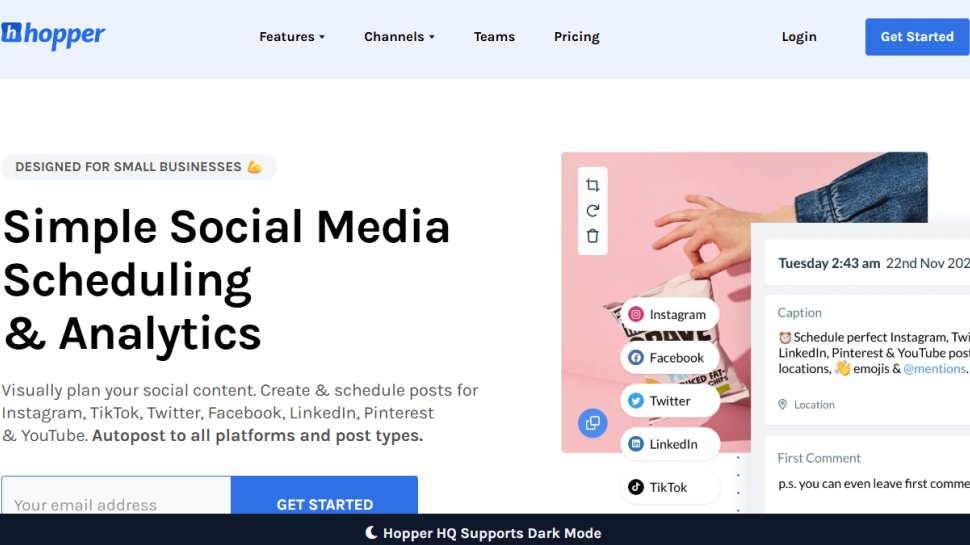
9. Hopper HQ
Reasons to buy
Reasons to avoid
Hopper HQ offers a stellar user interface. You have a neat dashboard to create and schedule posts ahead of time. Hopper HQ markets itself mainly as an Instagram scheduler but also works with other social platforms like X (Twitter), Facebook, and LinkedIn. You can create a post from your dashboard and publish it to multiple platforms simultaneously.
This platform gives you access to an interactive content calendar where you can drag and drop posts. You can use color codes to categorize your posts and make them easier to understand. Hopper HQ allows you to preview Instagram posts to see exactly how they’ll look when published. You’ll likely enjoy using Hopper HQ’s visually appealing dashboard with minimal clutter.
Features
Hopper HQ works with various social platforms, although the platform is centred on Instagram. You’ll first connect your social accounts to Hopper HQ to allow the app to publish posts directly. Afterwards, you can create posts and schedule them for automatic publishing at a later date.
This platform lets you bulk-upload photos and videos from your PC or import them from cloud storage tools like Dropbox and Google Drive. After uploading a picture, you can use Hopper HQ's editing tool to crop and tweak your images.
Hopper HQ gives you a calendar to plan your content schedule. After creating posts, you can drag and drop them directly into different dates on the calendar, and Hopper HQ automatically publishes them when due. You have access to analytics tools to evaluate the performance of your posts without leaving your Hopper HQ dashboard.
Agencies can use Hopper HQ to collaborate seamlessly on social posts. Administrators can invite as many team members as needed and control who can see certain social profiles. You control who can publish posts, who can create drafts, and who can only view posts but make no changes.
Hopper HQ doesn’t have a free plan but offers a 14-day free trial to test its features.
Best content calendar software for analytics
10. Brandwatch social media management
Reasons to buy
Reasons to avoid
Brandwatch has an excellent score in the user-friendliness criterion. It offers an intuitive calendar that makes organizing and scheduling your social posts easy. You can drag and drop posts across the calendar to change their schedule. This platform gives you a content library to keep graphics you want to use for your posts; you can store and use items in this library anytime you wish.
Brandwatch is accessible via a web browser or mobile app for iOS and Android devices. The mobile app (called Hub by Brandwatch) allows you to schedule and monitor your social posts on the go, especially when using a PC is uncomfortable.
Features
Brandwatch is an advanced social media content planner. It allows businesses to plan and publish social content from a single calendar. This platform is integrated with Facebook, Instagram, and LinkedIn, allowing you to schedule and publish posts automatically. You can publish promoted posts and optimize your ad campaigns directly from your Brandwatch dashboard.
This platform’s defining feature is its detailed analytics dashboard. It allows you to monitor your posts’ performance to a great extent. Your dashboard shows your post engagements, reach, and impressions in a visually appealing way. You can compare the performance of different posts or compare your performance to competitive benchmarks.
Brandwatch fosters collaboration within social media management teams. You can share your content calendar with colleagues, and they can make edits or leave comments depending on the permission you grant them. You can share your content calendar with external parties and receive feedback.
Users can upload images and videos directly from their devices or import them from external cloud storage services. Once you upload a graphic, you can reuse it as often as you wish.
Pricing
Brandwatch doesn’t have standard pricing; you’ll need to contact the sales team to negotiate a custom deal. Yet, Brandwatch has a reputation for being expensive, with costs running into thousands of dollars annually. This high price makes it unsuitable for small businesses with limited budgets.
You can ask for a demo to test Brandwatch before deciding whether to pay for full access.
Best content calendar software for small businesses
Reasons to buy
Reasons to avoid
Buffer offers an intuitive, uncluttered interface. It has a white background, with features arranged neatly on the top and left-hand sides of the dashboard. You can easily find any feature you need at any time.
You can access Buffer via a web browser or download the mobile app on your iOS or Android device. However, note that the mobile app does not offer all the features you’ll find on the desktop version.
Features
Buffer is a relatively affordable social media management tool designed for small businesses. It offers a content calendar that allows users to plan and publish social media posts seamlessly. Buffer is integrated with popular social platforms like Facebook, Instagram, Twitter, Pinterest, and YouTube, allowing you to post directly from your dashboard.
Buffer makes it easy to collaborate with other users. You can tag other users to provide feedback and easily share your content calendar with other people. You can set up a chain of approval that controls when a post can be scheduled for publishing.
Buffer comes with an artificial intelligence assistant like many rival tools. This AI assistant helps you generate ideas, translate posts, rewrite content, and more. It enables you to create compelling social media posts that will resonate with your audience.
You can upload both images and videos to Buffer. Buffer allows you to post videos directly to Instagram Reels, YouTube Shorts, and TikTok.
Overall
Buffer offers a free plan with basic features, unlike many competitors offering no free version. This free plan lets you connect up to 3 social channels and includes the basic planning & publishing features.
Buffer is an affordable tool compared to most competitors. Each paid plan has a 14-day free trial period to test the features before making a final decision.
Read our full Buffer review.
We've also featured the best calendar apps of 2025.
Get in touch
- Want to find out about commercial or marketing opportunities? Click here
- Out of date info, errors, complaints or broken links? Give us a nudge
- Got a suggestion for a product or service provider? Message us directly
- You've reached the end of the page. Jump back up to the top ^
Sign up to the TechRadar Pro newsletter to get all the top news, opinion, features and guidance your business needs to succeed!
Stefan has always been a lover of tech. He graduated with an MSc in geological engineering but soon discovered he had a knack for writing instead. So he decided to combine his newfound and life-long passions to become a technology writer. As a freelance content writer, Stefan can break down complex technological topics, making them easily digestible for the lay audience.

